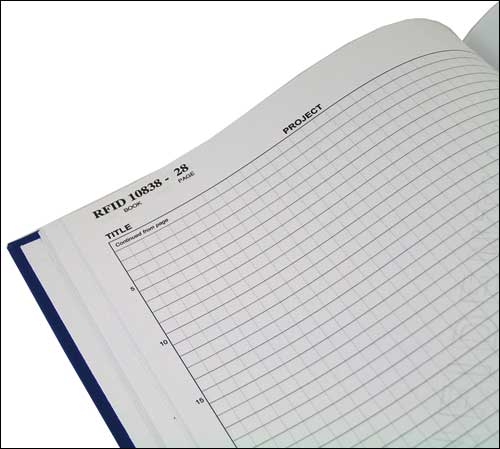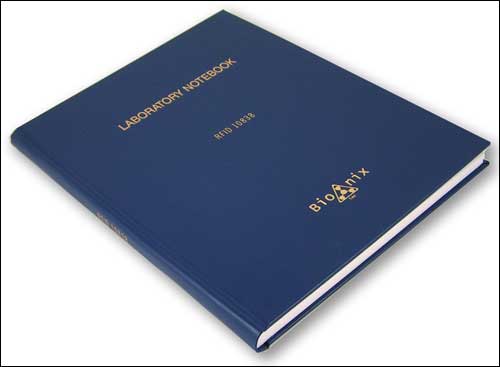Laboratory notebook manufacturer BookFactory is marketing a new RFID-enabled scientific notebook that a company can use to track the books’ movements around an office. Scientific notebooks can be of extreme value to pharmaceutical, food or medical firms because employees often record the development of new products, recipes and technologies within them by hand. The data written in the notebooks can be worth millions of dollars to a company that needs to prove it was the first to develop a new drug, flavor or other patentable idea.
BookFactory has teamed with FileTrail, a records-management software and technology firm that will install the RFID interrogator infrastructure and software to manage data regarding the books’ movements around an office. BookFactory will sell the books with embedded RFID tags that transmit an ID number to the interrogators.
For the past six years BookFactory has been selling serialized scientific notebooks to companies such as pharmaceutical firms and food manufacturers. Typically, a company assigns serialized paper notebooks to its employees, who then use them to record research results by hand. Because the material written in the books can be highly valuable, intellectual theft or industrial espionage are major concerns. To keep them safe, businesses maintain a watchful eye over the books. Workers can document their findings in the books, which remain the property of the company, never leaving the office.
At any particular time, a company can ask for a book to be returned, then lock it in a vault or copy it onto microfiche. In the case of a legal patent dispute, the firm can then present the book as evidence, which tends to be more convincing in a courtroom than electronic records, which can be manipulated. “No electrical system is foolproof,” says Andrew Gilmore, BookFactory’s president. A paper trail in a permanently bound book is often much more credible to a judge or jurors. “There’s no way to alter that,” he says, noting that even the pages are stitched together in such a way that they could not be removed without that action being apparent.

If the notebooks leave the office or end up in the wrong hands, however, the company then has a problem. FileTrail, which provides RFID tracking solutions for files and assets in offices, was approached by some of its customers and asked to find a way to track lab books, and to ensure they do not fall into the wrong hands, according to John Packowski, the company’s marketing and public relations director. Attaching an RFID sticker to a notebook itself is not a failsafe solution, he points out, because the tag could be removed.
In January of this year, Gilmore says, FileTrail approached BookFactory seeking a better solution, and the two companies designed the result. FileTrail would provide the RFID tag that BookFactory would embed in its books for customers seeking an RFID solution. FileTrail would also provide the software and reader installation to the company. The two companies announced the new system at the annual Institute of Food Technologists (IFT) meeting, held this week in Anaheim, Calif.
When the books are printed, BookFactory integrates an EPC Gen 2 UHF passive RFID tag into each cover so it cannot be removed. Each tag has a unique ID number encoded onto it. The company then uses an interrogator to read the tag and ensure it is working properly. When a user receives a book, he can scan its tag and input the unique serial number printed on the cover—as well as other data, such as to whom the notebook will be assigned, and any restrictions governing that book’s movement, such as which area of the office it is permitted to be in.
FileTrail will meet with each new customer, Packowski says, to set up an RFID system that meets that company’s specific security needs. In some cases, a business may want to simply secure its office so that no notebooks leave the premises—in such a scenario, the company can install a portal at the entryways to its building. The tag has a read range of 10 to 12 feet, Packowski says, so the reader would capture the ID number as the tag passed through the portal. FileTrail’s RFID Notebook Tracking Solution software would then receive that information and send an alert to those who need to know a notebook is leaving the facility.
In other cases, if a company wants to simply have the ability to run occasional inventory checks of its notebooks, that customer can purchase a handheld FileTrail RFMobile Portable RFID Detector to read ID numbers as a user passes the unit over desks or shelves.

In many scenarios, however, a user’s particular needs may be more complex. The software can be set up to provide a full visual map of an office, indicating the locations of all notebooks in real time. FileTrail’s RFID readers can be installed behind ceiling tiles, under desks and in doorways to allow the software to display each book’s whereabouts.
The software can also be instructed to send a notification or alert if an unauthorized action takes place, such as a notebook entering the wrong cubicle, leaving a cubicle or entering a copy room. What’s more, Packowski adds, the software can be integrated with a company’s existing personnel ID system, so that it could capture and record the identity of anyone who entered a cubicle or office, based on that person’s ID badge, at the time that a notebook was removed. Because the FileTrail software is Web-based, authorized users can access the system’s data via the Internet.
“We will work to understand what clients’ biggest needs are,” Packowski says. “Each deployment is likely to be different, and we can customize the reader installation, as well as the software to meet the client’s needs.”
The benefit for users will be the protection of intellectual property, Gilmore says, noting, “One of these books could be worth millions.”


